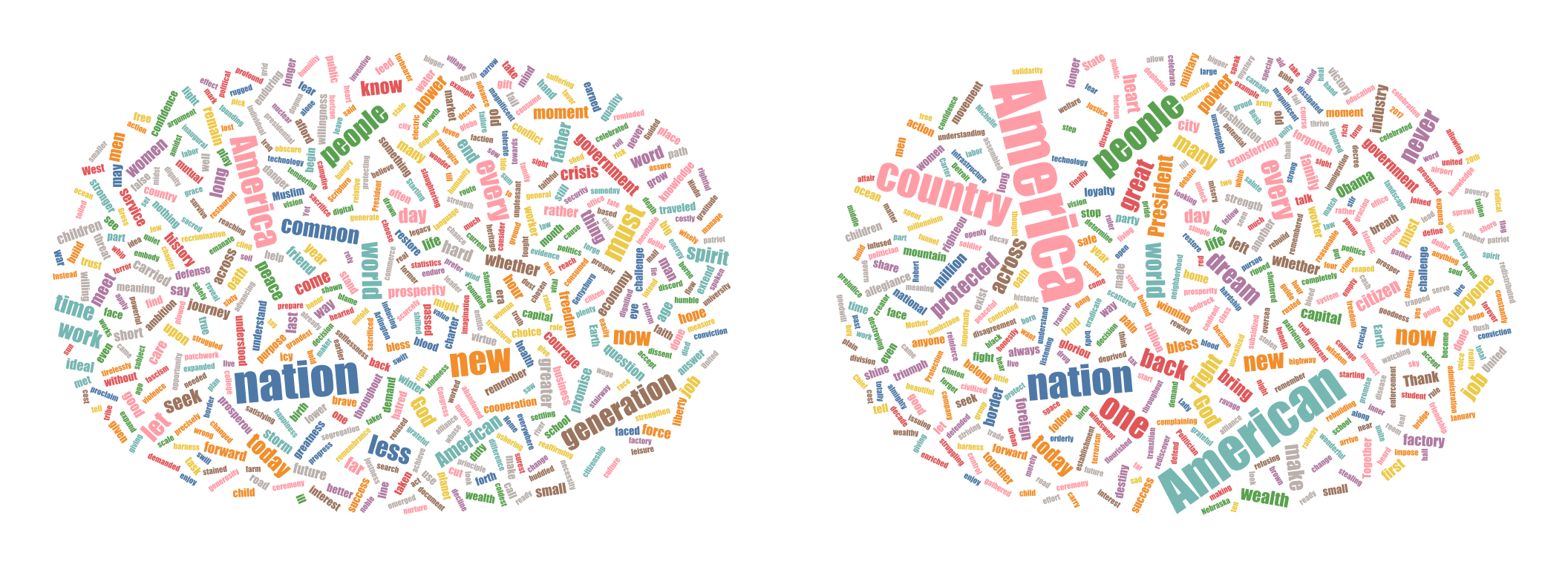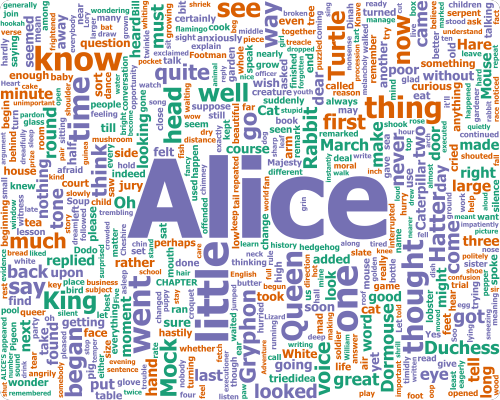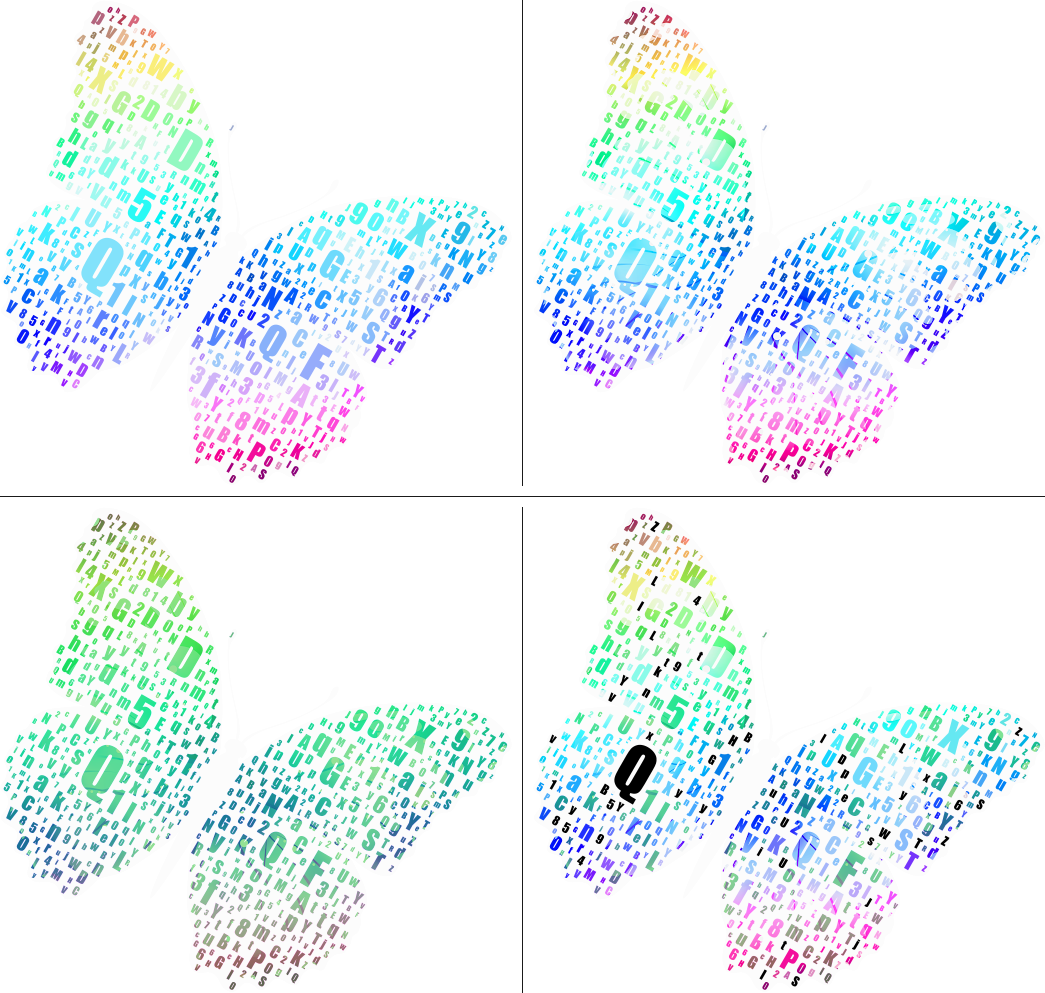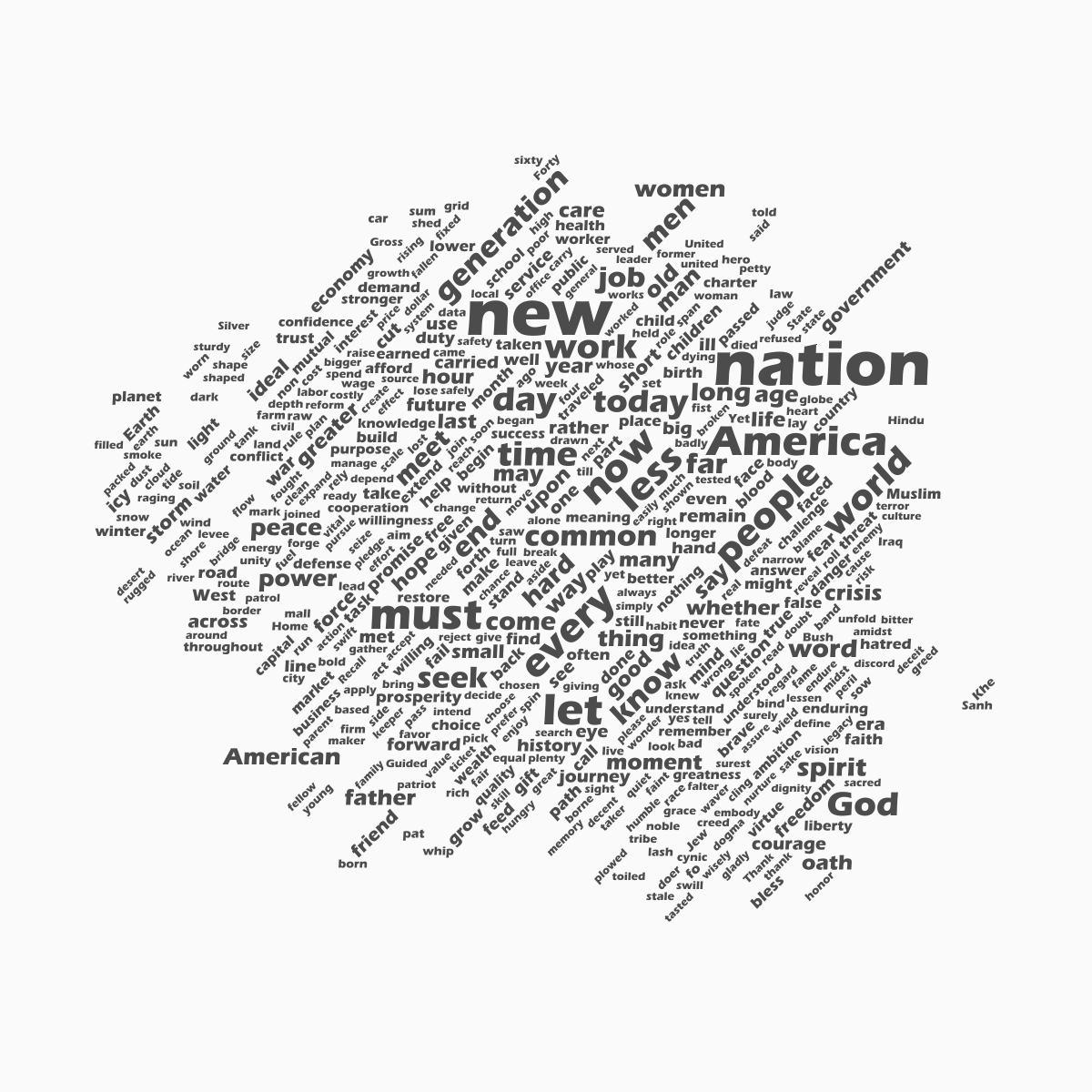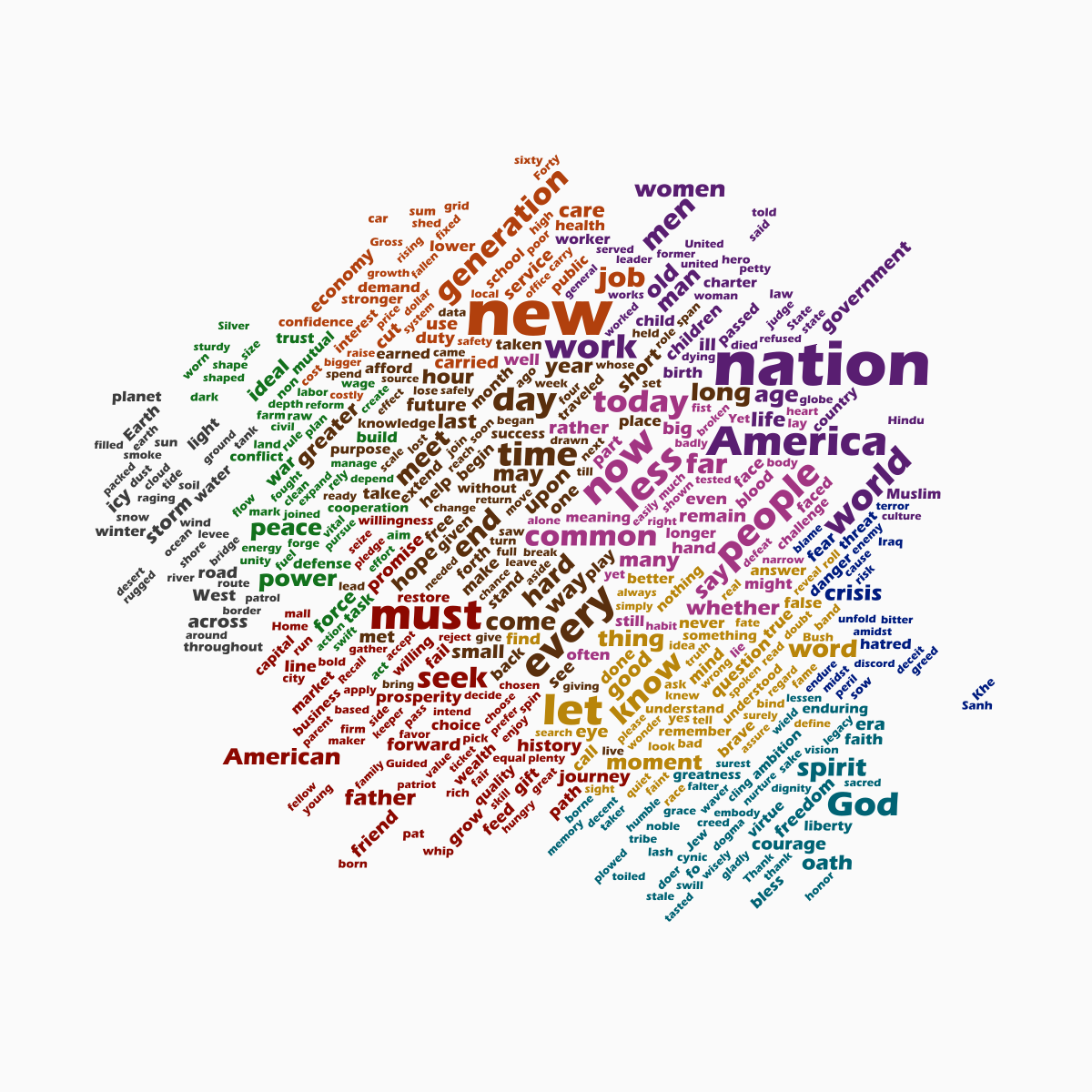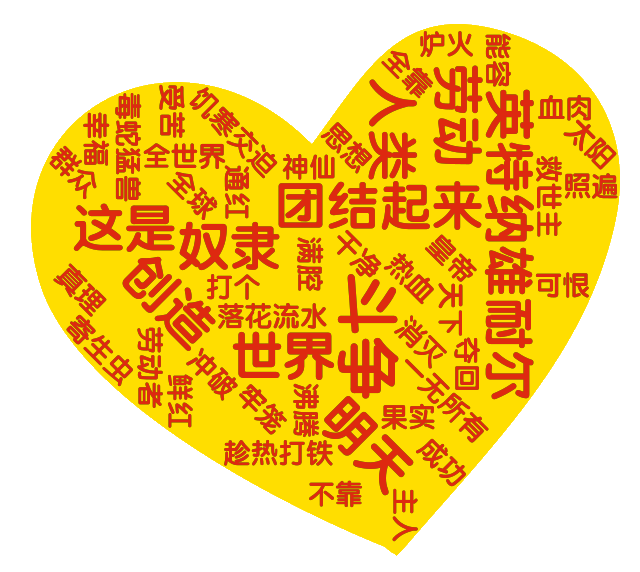This is a gallery of WordCloud.jl, which is automatically generated from WordCloud.examples (WordCloud v0.13.1). Run evalfile("generate.jl", ["doeval=true", "exception=true"]) in julia REPL to create this file.
- alice
- animation1
- animation2
- benchmark
- compare
- compare2
- custom
- fromweb
- gathering
- highdensity
- japanese
- juliadoc
- languages
- lettermask
- logo
- nomask
- outline
- pattern
- qianziwen
- random
- recolor
- semantic
- series
- 中文
using WordCloud
wc = wordcloud(
processtext(open(pkgdir(WordCloud) * "/res/alice.txt"), stopwords_extra=["said"]),
mask=pkgdir(WordCloud) * "/res/alice_mask.png",
color="#faeef8",
colors=:seaborn_dark,
angles=(0, 90),
density=0.55,
spacing = 3,) |> generate!
println("results are saved to alice.png")
paint(wc, "alice.png", background=outline(wc.mask, color="purple", linewidth=4))
wcThis animation shows how the initial layout is generated.
using WordCloud
textfile = pkgdir(WordCloud)*"/res/alice.txt"
wc = wordcloud(
processtext(open(textfile), maxnum=300),
masksize = (300, 200),
outline = 3,
angles = 0:90,
state = initialize!)gifdirectory = "animation1/uniform"
setpositions!(wc, :, (-1000,-1000))
@record gifdirectory overwrite=true filter=i->i%(2^(i÷100))==0 layout!(wc, style=:uniform)gifdirectory = "animation1/gathering"
setpositions!(wc, :, (-1000,-1000))
@record gifdirectory overwrite=true filter=i->i%(2^(i÷100))==0 layout!(wc, style=:gathering)println("results are saved in animation1")
wcThis animation shows the process of fitting the layout.
using CSV
using DataFrames
using WordCloud
df = CSV.File(pkgdir(WordCloud) * "/res/guxiang_frequency.txt", header=false) |> DataFrame;
words = df[!, "Column2"]
weights = df[!, "Column3"]
wc = wordcloud(words, weights, density=0.5)
gifdirectory = "animation2"
@record gifdirectory overwrite=true generate!(wc, 100, optimiser=WordCloud.Momentum())
println("results are saved in animation2")
wcTest the performance of different trainers
using WordCloud
using Random
# Random.seed!(8)
println("This test will take several minutes.")
@show Threads.nthreads()
words = [Random.randstring(rand(1:8)) for i in 1:200]
weights = randexp(length(words)) .* 2000 .+ rand(20:100, length(words));
wc1 = wordcloud(words, weights, mask=shape(ellipse, 500, 500, color=0.15), masksize=:original, angles=(0, 90, 45))
words = [Random.randstring(rand(1:8)) for i in 1:400]
weights = randexp(length(words)) .* 2000 .+ rand(20:100, length(words));
wc2 = wordcloud(words, weights, mask=shape(ellipse, 500, 500, color=0.15), masksize=:original, angles=(0, 90, 45))
words = [Random.randstring(rand(1:8)) for i in 1:5000]
weights = randexp(length(words)) .* 2000 .+ rand(20:100, length(words));
wc3 = wordcloud(words, weights, mask=shape(box, 2000, 2000, cornerradius=100, color=0.15), masksize=:original, angles=(0, 90, 45))
wcs = [wc1, wc1, wc2, wc3] # repeat wc1 to trigger compiling
ts = [WordCloud.Stuffing.trainepoch_E!,WordCloud.Stuffing.trainepoch_EM!,
WordCloud.Stuffing.trainepoch_EM2!,WordCloud.Stuffing.trainepoch_EM3!,WordCloud.Stuffing.trainepoch_D!,
WordCloud.Stuffing.trainepoch_P!,WordCloud.Stuffing.trainepoch_P2!,WordCloud.Stuffing.trainepoch_Px!]
es = [[] for i in 1:length(wcs)]
for (i, wc) in enumerate(wcs)
println("\n\n", "*"^10, "wordcloud - $(length(wc)) words on mask$(size(wc.mask))", "*"^10)
i == 4 && deleteat!(ts, lastindex(ts)-2:lastindex(ts)) # too slow
for (j, t) in enumerate(ts)
println("\n", i - 1, "==== ", j, "/", length(ts), " ", nameof(t))
layout!(wc, style=:uniform)
@time e = @elapsed generate!(wc, trainer=t, retry=1)
push!(es[i], "$(nameof(t)) - $(getparameter(wc, :epoch))" * (getstate(wc) == :generate! ? "✔ " : "✘ ") => e)
end
end
println("SUMMARY")
for (i, (wc, e)) in enumerate(zip(wcs, es))
println("##$(i - 1) $(length(wc))@$(size(wc.mask)):")
println(repr("text/plain", e))
endusing WordCloud
println("==Obama's==")
cs = WordCloud.randomscheme() # :Set1_8
as = WordCloud.randomangles() # (0,90,45,-45)
fs = WordCloud.randomfonts()
dens = 0.45 # not too high
wca = wordcloud(
open(pkgdir(WordCloud) * "/res/Barack Obama's First Inaugural Address.txt"),
colors=cs,
angles=as,
density=dens,
backgroundcolor=:maskcolor,
fonts=fs,
style=:uniform,
) |> generate!println("==Trump's==")
wcb = wordcloud(
open(pkgdir(WordCloud) * "/res/Donald Trump's Inaugural Address.txt"),
mask=getsvgmask(wca),
masksize=:original,
colors=cs,
angles=as,
density=dens,
backgroundcolor=:maskcolor,
maskcolor=getmaskcolor(wca),
fonts=fs,
state=identity, # disables the useless initialize! and layout! in advance
)Follow these steps to generate a wordcloud: initialize! -> layout! -> generate!
samewords = getwords(wca) ∩ getwords(wcb)
println(length(samewords), " same words")
for w in samewords
setcolors!(wcb, w, getcolors(wca, w))
setangles!(wcb, w, getangles(wca, w))
setfonts!(wcb, w, getfonts(wca, w))
end
initialize!(wcb)
println("=ignore defferent words=")
keep(wcb, samewords) do
@assert Set(wcb.words) == Set(samewords)
centers = getpositions(wca, samewords, mode=getcenter)
setpositions!(wcb, samewords, centers, mode=setcenter!) # manually initialize the position,
setstate!(wcb, :layout!) # and set the state flag
generate!(wcb, 1000, reposition=false, retry=1) # disables repositioning; retry=1 means no rescale
end
println("=pin same words=")
pin(wcb, samewords) do
layout!(wcb, style=:uniform)
generate!(wcb, 1000, retry=1) # enables repositioning while disabling rescaling
end
if getstate(wcb) != :generate!
println("=overall tuning=")
generate!(wcb, 1000, reposition=setdiff(getwords(wcb), samewords), retry=2) # only reposition the unique words
end
ma = paint(wca)
mb = paint(wcb)
h, w = size(ma)
println("results are saved in address_compare")
WordCloud.save("address_compare/compare.png", [ma mb])
gif = WordCloud.GIF("address_compare")
WordCloud.frame(wca, "Obama") |> gif
WordCloud.frame(wcb, "Trump") |> gif
WordCloud.Render.generate(gif, framerate=1)
wca, wcbThis is a more symmetrical and accurate way to generate comparison wordclouds, but it may be more time consuming.
using WordCloud
cs = WordCloud.randomscheme() # :Set1_8#
as = WordCloud.randomangles() # (0,90,45,-45)#
fs = WordCloud.randomfonts()
dens = 0.45 # not too high
wca = wordcloud(
open(pkgdir(WordCloud) * "/res/Barack Obama's First Inaugural Address.txt"),
colors=cs,
angles=as,
density=dens,
backgroundcolor=:maskcolor,
fonts=fs,
state=identity, # turn off the initialize! and layout! in advance
)
wcb = wordcloud(
open(pkgdir(WordCloud) * "/res/Donald Trump's Inaugural Address.txt"),
mask=getsvgmask(wca),
masksize=:original,
colors=cs,
angles=as,
density=dens,
backgroundcolor=:maskcolor,
maskcolor=getmaskcolor(wca),
fonts=fs,
state=identity,
)samewords = getwords(wca) ∩ getwords(wcb)
println(length(samewords), " same words")
@assert !hasparameter(wca, :uniquewords)
@assert !hasparameter(wcb, :uniquewords)
setparameter!(wca, setdiff(getwords(wca), samewords), :uniquewords)
setparameter!(wcb, setdiff(getwords(wcb), samewords), :uniquewords)
for w in samewords
setcolors!(wcb, w, getcolors(wca, w))
setangles!(wcb, w, getangles(wca, w))
setfonts!(wcb, w, getfonts(wca, w))
endinitialize!(wca)
initialize!(wcb)
keep(wca, samewords) do
layout!(wca, style=:uniform)
fit!(wca, 1000)
end
pin(wca, samewords) do
layout!(wca, style=:uniform) # place other words
end
centers = getpositions(wca, samewords, mode=getcenter)
setpositions!(wcb, samewords, centers, mode=setcenter!) # manually initialize the position,
pin(wcb, samewords) do
layout!(wcb, style=:uniform) # place other words
endfunction syncposition(samewords, pos, wca, wcb)
pos2 = getpositions(wca, samewords, mode=getcenter)
if pos != pos2
setpositions!(wcb, samewords, pos2, mode=setcenter!)
setstate!(wcb, :layout!)
end
pos2
end
function pinfit!(wc, samewords, ep1, ep2)
pin(wc, samewords) do
fit!(wc, ep1)
end
fit!(wc, ep2, reposition=getparameter(wc, :uniquewords)) # only reposition the unique words
end
pos = getpositions(wca, samewords, mode=getcenter)
while getparameter(wca, :epoch) < 2000 && getparameter(wcb, :epoch) < 2000
global pos
pinfit!(wca, samewords, 200, 50)
pos = syncposition(samewords, pos, wca, wcb)
pinfit!(wcb, samewords, 200, 50)
pos = syncposition(samewords, pos, wcb, wca)
if getstate(wca) == getstate(wcb) == :fit!
break
end
end
println("Takes $(getparameter(wca, :epoch)) and $(getparameter(wcb, :epoch)) epochs")
WordCloud.printcollisions(wca)
WordCloud.printcollisions(wcb)ma = paint(wca)
mb = paint(wcb)
h, w = size(ma)
println("results are saved in address_compare2")
WordCloud.save("address_compare2/compare2.png", [ma mb])
gif = WordCloud.GIF("address_compare2")
WordCloud.frame(wca, "Obama") |> gif
WordCloud.frame(wcb, "Trump") |> gif
WordCloud.Render.generate(gif, framerate=1)
wca, wcbusing WordCloud
wc = wordcloud(
processtext(open(pkgdir(WordCloud) * "/res/alice.txt"), maxweight=1, maxnum=300),
# mask = pad(WordCloud.tobitmap(shape(ellipse, 600, 500, color=(0.98, 0.97, 0.99), backgroundcolor=0.97)), 0.1),
mask=shape(ellipse, 600, 500, color=(0.98, 0.97, 0.99), backgroundcolor=0.97, backgroundsize=(700, 550)),
masksize=:original,
colors=:seaborn_icefire_gradient,
angles=-90:90,
state=identity, # turn off the useless initialize! and layout! in advance
)
setwords!(wc, "Alice", "Alice in Wonderland") # replace the word 'Alice' with 'Alice in Wonderland'
setangles!(wc, "Alice in Wonderland", 0) # make it horizontal
setcolors!(wc, "Alice in Wonderland", "purple");
setfontsizes!(wc, "Alice in Wonderland", size(wc.mask, 2) / length("Alice in Wonderland"))
initialize!(wc, "Alice in Wonderland")
r = size(wc.mask, 2) / size(getimages(wc, "Alice in Wonderland"), 2) * 0.95
setfontsizes!(wc, "Alice in Wonderland", r * size(wc.mask, 2) / length("Alice in Wonderland")) # set a big font size
initialize!(wc, "Alice in Wonderland") # init it after adjust it's style
setpositions!(wc, "Alice in Wonderland", reverse(size(wc.mask)) .÷ 2, mode=setcenter!) # center it
pin(wc, "Alice in Wonderland") do
initialize!(wc) # init inside `pin` to reset the size of other words
generate!(wc)
end
println("results are saved to custom.svg")
paint(wc, "custom.svg")
wcusing WordCloud
using HTTP
url = "http://en.wikipedia.org/wiki/Special:random"
try
resp = HTTP.request("GET", url, redirect=true)
println(resp.request)
content = resp.body |> String
wc = wordcloud(content |> html2text |> processtext) |> generate!
println("results are saved to fromweb.svg")
paint(wc, "fromweb.svg")
wc
catch e
println(e)
endBy setting style=:gathering in the layout! function, larger words will be positioned closer to the center.
using WordCloud
wc = wordcloud(
open(pkgdir(WordCloud) * "/res/alice.txt"),
angles=0, density=0.55,
mask=squircle, rt=2.5 * rand(),
state=initialize!)
layout!(wc, style=:gathering, level=5, centralword=true)
pin(wc, "Alice") do # keep "Alice" in the center
generate!(wc, reposition=0.7) # exclude the top 30% of words from repositioning
end
println("results are saved to gathering.svg")
paint(wc, "gathering.svg")
wcusing WordCloudIn certain scenarios, there might be a need for generating a high-density output, and you might attempt to achieve it using the following code:
wc = wordcloud(
open(pkgdir(WordCloud)*"/res/alice.txt"),
mask = shape(box, 500, 400, cornerradius=10),
colors = :Dark2_3,
angles = (0, 90), # spacing = 2,
density = 0.7) |> generate!
paint(wc, "highdensity.png")However, there are situations where it fails to function as intended.
This is mainly because the minimum gap between two words is set to 2 pixels, controlled by the spacing parameter of the wordcloud function.
In cases where the image is small, the cost of 2 pixels becomes relatively higher. To address this issue, you have the option to set spacing=0 or spacing=1. Alternatively, increasing the image size can also alleviate the issue.
wc = wordcloud(
open(pkgdir(WordCloud) * "/res/alice.txt"),
mask=shape(box, 500 * 2, 400 * 2, cornerradius=10 * 2),
masksize=:original,
colors=:Dark2_3,
angles=(0, 90),
density=0.7) |> generate!
paint(wc, "highdensity.png", ratio=0.5)println("results are saved to highdensity.png")
wcThis package does not come with an integrated Japanese tokenizer. You can leverage the TinySegmenter.jl package instead.
using WordCloud
import TinySegmenter
WordCloud.settokenizer!("jpn", TinySegmenter.tokenize)
wc = wordcloud("花は桜木、人は武士", language="jpn") |> generate! # the argumet `language` is optional
println("results are saved to japanese.svg")
paint(wc, "japanese.svg")
wcusing WordCloud
function drawjuliacircle(sz)
juliacirclessvg = WordCloud.Render.Drawing(sz, sz, :svg)
WordCloud.Render.origin()
WordCloud.Render.background(0, 0, 0, 0)
WordCloud.Render.juliacircles(sz ÷ 4)
WordCloud.Render.finish()
juliacirclessvg
end
docs = (readdir(joinpath(dirname(Sys.BINDIR), "share/doc/julia/html/en", dir), join=true) for dir in ["manual", "base", "stdlib"])
docs = docs |> Iterators.flatten
words, weights = processtext(maxnum=400, maxweight=1) do
counter = Dict{String,Int}()
for doc in docs
content = html2text(open(doc))
countwords(content, counter=counter)
end
counter
end
wc = wordcloud(
[words..., "∴"], # add a placeholder for julia-logo
[weights..., weights[1]],
density=0.55,
mask=shape(box, 900, 300, cornerradius=0, color=0.95),
masksize=:original,
colors=((0.796, 0.235, 0.20), (0.584, 0.345, 0.698), (0.22, 0.596, 0.149)),
angles=(0, -45, 45),
# fonts = "Verdana Bold",
maxfontsize = 300,
)
setangles!(wc, "julia", 0)
# setangles!(wc, "function", 45)
# initialize!(wc, "function")
setcolors!(wc, "julia", (0.796, 0.235, 0.20))
# setfonts!(wc, "julia", "forte")
initialize!(wc, "julia")
juliacircles = drawjuliacircle(getfontsizes(wc, "∴") |> round)
setsvgimages!(wc, "∴", juliacircles) # replace image
sz1 = size(getimages(wc, "∴"))
sz2 = size(getimages(wc, "julia"))
y1, x1 = (size(wc.mask) .- (sz1[1], sz1[2] + sz2[2])) .÷ 2
y2 = (size(wc.mask, 1) - sz2[1]) ÷ 2
x1 = round(Int, x1 * 0.9)
setpositions!(wc, "∴", (x1, y1))
setpositions!(wc, "julia", (x1 + sz1[2], y2))
pin(wc, ["julia", "∴"]) do
layout!(wc)
generate!(wc, 2000)
end
println("results are saved to juliadoc.svg")
# paint(wc, "juliadoc.png")
paint(wc, "juliadoc.svg")
wcFor languages that are not processed perfectly, you can refer to the example for Chinese and the example for Japanese. Or you can directly input the data in the form of a "word => weight" list, as illustrated in the following example.
using WordCloud
words_weights = [
"普通话" => 939.0,
"Español" => 485.0,
"English" => 380.0,
"हिन्दी" => 345.0,
"Português" => 236.0,
"বাংলা" => 234.0,
"Русский" => 147.0,
"日本語" => 123.0,
"粤语" => 86.1,
"Tiếng Việt" => 85.0,
"Türkçe" => 84.0,
"吴语" => 83.4,
"मराठी" => 83.2,
"తెలుగు" => 83.0,
"한국어" => 81.7,
"Français" => 80.8,
"தமிழ்" => 78.6,
"مصري" => 77.4,
"Deutsch" => 75.3,
"اردو" => 70.6,
"ꦧꦱꦗꦮ" => 68.3,
"پنجابی" => 66.7,
"Italiano" => 64.6,
"فارسی" => 57.2,
"ગુજરાતી" => 57.1,
"भोजपुरी" => 52.3,
"هَوْسَ" => 51.7
]
wc = wordcloud(words_weights) |> generate!
println("results are saved to languages.svg")
paint(wc, "languages.svg")
wcusing WordCloud
mask = rendertext("World", 1000, border=10, color=0.9, backgroundcolor=0.98, type=:svg, font="Sans Bold")
words = repeat(["we", "are", "the", "world"], 150)
weights = repeat([1], length(words))
wc = wordcloud(
words, weights,
mask=mask,
angles=0,
colors=("#006BB0", "#EFA90D", "#1D1815", "#059341", "#DC2F1F"),
density=0.55,
transparent=0.98,
) |> generate!
println("results are saved to lettermask.svg")
paint(wc, "lettermask.svg", background=false)
wcIt is the code to draw this repo's logo
using WordCloud
Luxor = WordCloud.Render.Luxor
function cloudshape(height, args...; backgroundcolor=(0, 0, 0, 0))
height = ceil(height)
r = height / 2
d = Luxor.Drawing((2height, height)..., :svg)
Luxor.origin()
Luxor.background(parsecolor(backgroundcolor))
Luxor.setcolor(parsecolor((0.22, 0.596, 0.149)))
Luxor.pie(0, 0, r, 0, 2π, :fill)
Luxor.setcolor(parsecolor((0.584, 0.345, 0.698)))
Luxor.pie(r, r, r, -π, 0, :fill)
Luxor.setcolor(parsecolor((0.796, 0.235, 0.20)))
Luxor.Luxor.pie(-r, r, r, -π, 0, :fill)
Luxor.finish()
d
end
wc = wordcloud(
repeat(string.('a':'z'), 5),
repeat([1], 26 * 5),
mask=cloudshape(500),
masksize=:original,
transparent=(0, 0, 0, 0),
colors=1,
angles=-90:0,
fonts="JuliaMono Black",
density=0.7,
)
generate!(wc, 2000, retry=1)
recolor!(wc, style=:main)
println("results are saved to logo.svg")
paint(wc, "logo.svg", background=false)
wcThe word clouds generated by WordCloud.jl are always with a mask, but we can imitate the no-mask-style through the following steps:
- set a lower density
- set the background color as the mask color
- gathering style placement
- generating with repositioning off
using WordCloud
wc = wordcloud(
processtext(open(pkgdir(WordCloud) * "/res/Donald Trump's Inaugural Address.txt"), maxweight=1, minweight=0),
density=0.3,
mask=box,
cornerradius=0,
masksize=(1200, 900),
backgroundcolor=:maskcolor,
angles=rand((0, (0, 90))),
state=identity,
)place words in the center of the background to prevent encountering the mask boundary
layout!(wc, style=:gathering, reorder=WordCloud.shuffle, level=6, rt=1) # a proper level is important, and so is luck
paint(wc, "nomask-placewords.svg")
prevent repositioning words to the surrounding blank space
generate!(wc, reposition=false)
paint(wc, "nomask.svg")
wcusing WordCloud
words = (1:200) .% 10 .|> string
weights = (1:200) .% 11 .+ 1You can directly set the outline and maskcolor in wordcloud
wc1 = wordcloud(
words, weights,
mask = squircle, rt=0.5,
masksize = (300, 200),
maskcolor = "AliceBlue",
outline = 6, linecolor = "navy"
) |> generate!Or if you already have a SVG mask with outline, you should set a proper transparent region in wordcloud
svgmask = shape(squircle, 300, 200, outline=6, linecolor="navy", color="AliceBlue")
wc1 = wordcloud(
words, weights,
mask = svgmask,
transparent=c -> c != WordCloud.torgba("AliceBlue"), # the outline should be regarded as transparent too
) |> generate!
paint(wc1, "outline.svg")
println("results are saved to outline.svg")If you already have a bitmap mask without outline, you can outline it before painting
bitmapmask = WordCloud.tobitmap(shape(squircle, 300, 200, color="AliceBlue", backgroundsize=(312, 212)))
wc2 = wordcloud(
words, weights,
mask = bitmapmask,
) |> generate!
paint(wc2, "outline.png", background=outline(getmask(wc2), color="navy", linewidth=6, smoothness=0.8))
println("results are saved to outline.png")wc1, wc2The engine is designed for general purpose, so the outputs don't have to be text, and shapes are OK
using WordCloud
sc = WordCloud.randomscheme() |> unique # unique makes Int -> Vector{Int}
l = 200
wc = wordcloud(
repeat(["placeholder"], l), repeat([1], l),
mask=shape(box, 400, 300, color=WordCloud.randommaskcolor(sc)),
masksize=:original,
state=identity)words&weightsare just placeholders- style arguments like
colors,anglesanddensityhave no effect
And, you should manually initialize images for the placeholders, instead of calling initialize!
dens = 0.6
sz = 3expm1.(rand(l)) .+ 1
sz ./= √(sum(π * (sz ./ 2).^2 ./ dens) / prod(size(wc.mask))) # set a proper size according to the density
## svg version
# shapes = [shape(ellipse, round(sz[i]), round(sz[i]), color=rand(sc)) for i in 1:l]
# setsvgimages!(wc, :, shapes)
## bitmap version
shapes = WordCloud.tobitmap.([shape(ellipse, round(sz[i]), round(sz[i]), color=rand(sc)) for i in 1:l])
setimages!(wc, :, shapes)
setstate!(wc, :initialize!) # set the state flag after manual initialization
@record "pattern_animation" overwrite=true generate!(wc, retry=1, optimiser=WordCloud.Momentum(η=1/8))
# generate!(wc, retry=1, optimiser=WordCloud.Momentum(η=1/8)) # turn off rescale attempts. manually set images can't be rescaled
println("results are saved to pattern.png")
paint(wc, "pattern.png")
wcusing WordCloud
words = "天地玄黄宇宙洪荒日月盈昃辰宿列张寒来暑往秋收冬藏闰余成岁律吕调阳云腾致雨露结为霜金生丽水玉出昆冈剑号巨阙珠称夜光果珍李柰菜重芥姜海咸河淡鳞潜羽翔龙师火帝鸟官人皇始制文字乃服衣裳推位让国有虞陶唐吊民伐罪周发殷汤坐朝问道垂拱平章"
words = [string(c) for c in words]
weights = rand(length(words)).^2 .* 100 .+ 30
wc = wordcloud(words, weights, spacing=0, density=0.75)
generate!(wc)using WordCloud
using Random
words = [randstring(rand(1:8)) for i in 1:300]
weights = randexp(length(words))
wordcloud(words, weights) |> generate!using WordCloud
using Randomistrans = c -> maximum(c[1:3]) * (c[4] / 255) < 128
background, mask = loadmask(pkgdir(WordCloud) * "/res/butterfly.png", transparent=istrans, return_bitmask=true)
showmask(background, mask, highlight=(1, 0, 0, 0.7))showmask might be helpful to find a proper istrans function. using Images may be required.
words = [randstring(1) for i in 1:600]
weights = randexp(length(words)) .+ 1
wc = wordcloud(
words, weights,
mask=background,
maskcolor=:original,
colors="LimeGreen",
angles=-30,
density=0.4,
transparent=istrans,
spacing=1,
) |> generate!;
background2 = loadmask(getmask(wc), color=0.99)recolor!(wc, style=:average)
avgimg = paint(wc, background=background2)recolor!(wc, style=:clipping)
clipimg = paint(wc, background=background2)recolor!(wc, style=:reset)
recolor!(wc, style=:blending, alpha=0.5) # blending with origin color - LimeGreen
blendimg = paint(wc, background=background2)styles can also be mixed
# setcolors!(wc, :, "LimeGreen")
recolor!(wc, style=:reset)
recolor!(wc, 1:3:length(words), style=:average) # vector index is ok
recolor!(wc, 2:3:length(words), style=:clipping)
recolor!(wc, 3:3:length(words), style=:blending)
setcolors!(wc, 200:250, "black")
recolor!(wc, 200:250, style=:reset)
setcolors!(wc, 1, "black")
recolor!(wc, 1, style=:reset) # single index is ok
mixstyleimg = paint(wc, background=background2)h, w = size(avgimg)
lw = 21
lc = eltype(avgimg)(parsecolor(0.1))
vbar = zeros(eltype(avgimg), (h, lw))
hbar = zeros(eltype(avgimg), (lw, 2w + lw))
vbar[:, lw ÷ 2 + 1] .= lc
hbar[lw ÷ 2 + 1, :] .= lc
image = [avgimg vbar clipimg; hbar; blendimg vbar mixstyleimg]
println("results are saved to recolor.png")
WordCloud.save("recolor.png", image)
wcusing WordCloud
words_weights = processtext(open(pkgdir(WordCloud) * "/res/Barack Obama's First Inaugural Address.txt"))
words_weights = Dict(zip(words_weights...))The positions of words can be initialized with pre-trained word vectors so that similar words will appear near each other.
using Embeddings
using TSne
const embtable = load_embeddings(GloVe{:en})
const get_word_index = Dict(word => ii for (ii, word) in enumerate(embtable.vocab))
function get_embedding(word)
ind = get_word_index[word]
emb = embtable.embeddings[:,ind]
return emb
end
wordvec = Dict()
for k in keys(words_weights)
if k in keys(get_word_index)
wordvec[k] = get_embedding(k)
elseif lowercase(k) in keys(get_word_index)
wordvec[k] = get_embedding(lowercase(k))
else
pop!(words_weights, k)
println("remove ", k)
end
end
words = keys(wordvec) |> collect
vectors = hcat(values(wordvec)...)
embedded = tsne(vectors', 2)wc = wordcloud(
words_weights,
mask=box,
masksize=(1000, 1000),
cornerradius=0,
density=0.3,
colors=0.3,
backgroundcolor=:maskcolor,
state=initialize!,
# angles = (0, 45), fonts = "Eras Bold ITC", maskcolor=0.98,
)
pos = embedded
mean = sum(pos, dims=1) / size(pos, 1)
r = maximum(sqrt.(pos[:,1].^2 + pos[:,2].^2))
pos = (pos .- mean) ./ 2r
sz = collect(reverse(size(wc.mask)))'
sz0 = collect(getparameter(wc, :masksize)[1:2])'
pos = round.(Int, pos .* sz0 .+ sz ./ 2)
setpositions!(wc, words, eachrow(pos), mode=setcenter!)
setstate!(wc, :layout!)
generate!(wc, reposition=false)
paint(wc, "semantic_embedding.png")Words can be further colored according to semantic clustering
using Clustering
V = embedded
G = V * V'
H = sum(V.^2, dims=2)
D = max.(0, (H .+ H' .- 2G))
D ./= sum(D) / length(D)
D .= .√D # the distance matrix
tree = hclust(D, linkage=:ward)
lb = cutree(tree, h=3, k=8)
println("$(length(lb)) words are divided into $(length(unique(lb))) groups")colors = parsecolor(:seaborn_dark)
setcolors!(wc, words, colors[lb .% length(colors) .+ 1])
recolor!(wc, style=:reset)
paint(wc, "semantic_clustering.png")wcThis example shows how to generate a dynamic word cloud on series data.
We use the GDP of countries from 2000 to 2020 as an example.
using WorldBankData
using DataFrames
df0 = wdi("NY.GDP.MKTP.CD", "all", 2000, 2020) # GDP from 2000 to 2020
df0.year = round.(Int, df0[!, :year])
df = unstack(df0, :year, :NY_GDP_MKTP_CD)
country_groups = ["XC", "EU", "XE", "XD", "XF", "ZB", "ZT", "XH", "XI", "XG", "ZJ", "XJ", "XL", "XO",
"XM", "XN", "ZQ", "XQ", "XP", "XU", "XY", "OE", "ZG", "ZF", "XT"]|>Set # https://rpubs.com/federicoganz/749793
countrymask = .!occursin.(r"\d" , df.iso2c) .& .!in.(df.iso2c, Ref(country_groups))
df = df[countrymask, 2:end]
df[!, 2:end] .= sqrt.(df[!, 2:end] ./ length.(df.country))
df.country = replace.(df.country, " "=>"\n") # some names are too long
for i in 1:size(df, 1) # interpolation, fill missing
for j in 3:size(df, 2)
if ismissing(df[i, j])
df[i, j] = df[i, j-1]
end
end
endusing WordCloud
function gather!(wc, i=1:length(wc), r=1)
O = reverse(size(getmask(wc))) .÷ 2
order1 = sortperm(sortperm(getpositions(wc, i, mode=getcenter), by=p->sum((p .- O).^2)))
order2 = sortperm(getweights(wc, i))
radial = Int.(order2 .> order1)
gatheritem!.(wc, WordCloud.index(wc, i), r.*radial);
end
function gatheritem!(wc, i, r=1)
r == 0 && return
C = getpositions(wc, i, mode=getcenter)
Δ = sign.(reverse(size(getmask(wc))) .÷ 2 .- C)
setpositions!(wc, i, C .+ r .* Δ, mode=setcenter!)
endThese two functions are ussed to forcing large words to the center, but are not essential.
wc = wordcloud(df.country, 1, angles=0)
gif = WordCloud.GIF("series")
println("results are saved in series")
@assert length(unique(df[!, 1])) == length(df[!, 1])
initialized = false
for name in names(df)[2:end] # the first column is word list
words = df[!, 1]
weights = df[!, name]
missingmask = ismissing.(weights)
setweights!.(wc, words[.!missingmask], weights[.!missingmask])
println("#"^9, name, "#"^9)
ignore(wc, words[missingmask]) do
global initialized
words = getwords(wc)
pos = getpositions(wc, mode=getcenter)
initialize!(wc)
if !initialized
layout!(wc, style=:gathering)
initialized = true
else
setpositions!(wc, words, pos, mode=setcenter!)
setstate!(wc, :layout!)
end
generate!(wc, callback_pre=ep->(ep%5==0 && gather!(wc, 1:length(wc)÷5, 5)))
WordCloud.frame(wc, name) |> gif
# display(wc)
end
end
WordCloud.Render.generate(gif, framerate=4)
wc中文分词功能没有内建,可以通过PythonCall调用python版的结巴分词。
using CondaPkg; CondaPkg.add("jieba")
using WordCloud
using PythonCall
jieba = pyimport("jieba")
TheInternationale = "起来,饥寒交迫的奴隶!\n起来,全世界受苦的人!\n满腔的热血已经沸腾,\n要为真理而斗争!\n旧世界打个落花流水,\n奴隶们起来,起来!\n不要说我们一无所有,\n我们要做天下的主人!\n\n这是最后的斗争,\n团结起来到明天,\n英特纳雄耐尔\n就一定要实现!\n这是最后的斗争,\n团结起来到明天,\n英特纳雄耐尔\n就一定要实现!\n\n从来就没有什么救世主,\n也不靠神仙皇帝!\n要创造人类的幸福,\n全靠我们自己!\n我们要夺回劳动果实,\n让**冲破牢笼!\n快把那炉火烧得通红,\n趁热打铁才能成功!\n\n是谁创造了人类世界?\n是我们劳动群众!\n一切归劳动者所有,\n哪能容得寄生虫?!\n最可恨那些毒蛇猛兽,\n吃尽了我们的血肉!\n一旦把它们消灭干净,\n鲜红的太阳照遍全球!\n"
jieba.add_word("英特纳雄耐尔")
方案1:你可以使用WordCloud.settokenizer!为中文注册分词器。当检测到中文文本输入时该分词器会被自动调用。
WordCloud.settokenizer!("zh", t->pyconvert(Vector{String}, jieba.lcut(t)))
wc = wordcloud(TheInternationale)
@show wc方案2:如果你只是单次使用不想注册,也可以传入手动分词之后的的词列表。
wc = wordcloud(
processtext(pyconvert(Vector{String}, jieba.lcut(TheInternationale))),
colors="#DE2910",
# mask = WordCloud.randommask(400, color="#FFDE00"),
mask=pkgdir(WordCloud) * "/res/heart_mask.png",
maskcolor="#FFDE00",
masksize=500,
density=0.6,
) |> generate!
println("结果保存在 中文.png")
paint(wc, "中文.png")
wc





